Inflated Form From Economical Sheeting
(This is a continuation of the first page.)
Seamless sheets are ready to use for inflated forms, and by 2020 we can buy pre-seamed plastic sheets to immediately inflate for larger building spans, as a speedier options than the ordinary PE (plain polyethylene sheets which can somehow be cleverly seamed together as an extra building step).The extra large sheets are intended for the greenhouse industry, and gradually other uses for translucent roofing can be imagined. These plastics are much more expensive than the simpler PE (polyethylene) sheets, but these greenhouse grades of sun resistant plastic are far stronger too. My interest in writing is to integrate building ideas of both greenhouse and cement based structures, so the range of subjects is expanding past one page. This page is intended to link newly related ideas and consider more details for building, but also to check feasibility through modeling as a start, based on decades of my experimental building experiences.
![]()
Readers are welcomed to notify me of prior works which are closely related to models described here, so that originators who deserve mention can be cited and links can be added to their work, (if available). For now, key word searches by the reader is recommended, to verify the state of the inflated form work beyond 2020.(Vendors of plastic sheet can be found on the internet, to verify costs, delivered to your location).
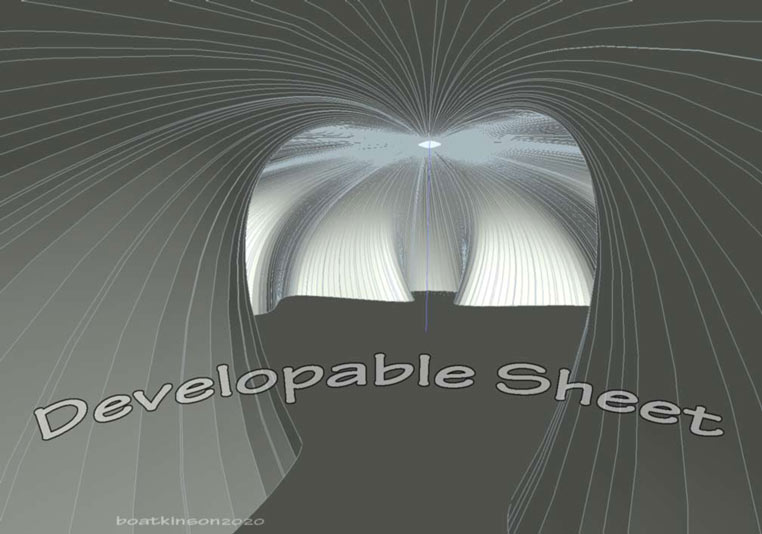
The above image is the same model of the first page, but here it is enlarged in 3D software, to consider the use of extra larger sheets which does verify some limited standing room, and promises options for adjusting the curvatures in real life, as explained further below, (which allows hands on physical exploration of inflated possibilities). My models are preliminary comparisons of variable possibilities, just to see if further exploration is worthy of building. The aim of fast construction installation is to take advantage of generic material like a square sheet and quickly get an interesting organic form with little investment of labor, all of which could provide eye catching structures for many kinds of purposes, (both for private or commercial). This kind of adaptable structure looks very promising for the inflation work, yet it requires far more tooling innovation for cement structuring in case the inflated form is used to build a rigid stone structure. This series may or may not continue, depending on response which sometimes spark off new additions..
The key purpose of this exploration is to find developable surfaces from simple inflation of single sheets. Factory enlarged sheets, ready to use, simplify the prototyper's tasks while some builders have enlarged sheets on- site, which is more work. The extra large sheets allow increasing the corrugation, (or scalloping), of inflated surfaces, (most useful for adding strength to cement roofs), but as yet this is an adventurous proposition to prove in practice. Are corrugations helpful to greenhouse structures? I imagine math-modeling could guide later installation of cushion-topped poles, to hold up the plastic, to avoid electrical costs of continuous fan blowers. Modeling the resulting effect will be added below. Given enough poles to be installed after the sheet has been inflated, adequate sheet quality should hold up snow loads and strong winds, in case enough stones and dirt also weigh down the edges, and providing the cushioned poles evenly distribute the loads.
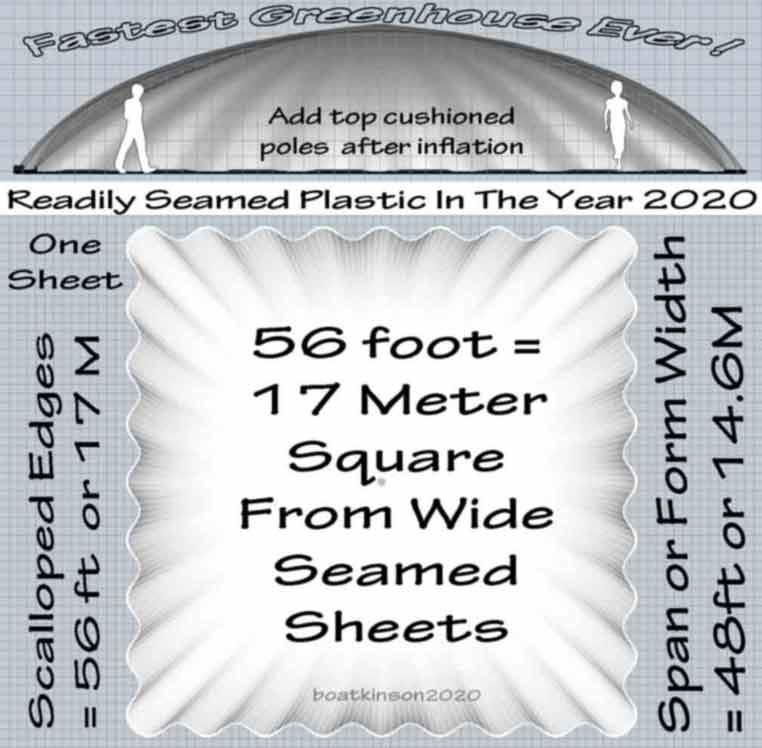
As of this writing the author has not used inflated forms, (besides an inflated-fractal-coffer method, to build a dome). Instead the exploration of rigid molding for cement and rigid frame structures for wood, metal, plastic, skylights and greenhouses, along with extensive 3D modeling has occupied my 50 years of unceasing building experimentation. The term "developable surfaces", is a term which guides possible surface outcomes and for rigid materials is very restrictive; whereas, flowing surfaces like stretchable materials and flowing cement, develop freer curvature, (depending on form work feasibility). Material variability forces approximations in computer modeling which gets adjusted in real life, because each physical sheet material adds unique qualities, and the range of tools and budgeting widely affects outcomes. I was quite content working with low budgets and incorporating conservational reuses of crude materials, which has an effect all it's own, (and ignores the finishing- touches usually demanded by consumers).
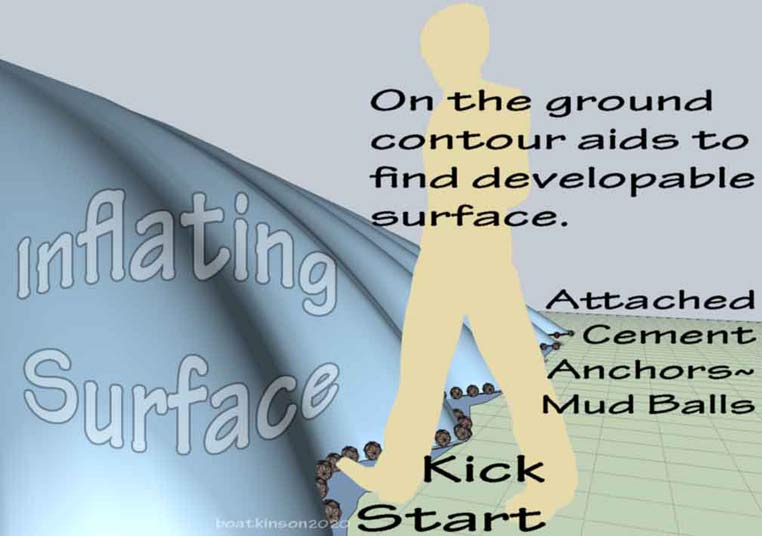
The possibility of shaping up an inflated sheet by use of attached cement anchors, and then kick starting the shape of scalloped edges, might even be fun to do. Below is a simple method to attach ball-shaped anchors to a sample sheet, but it proves the feasibility of preparing a very large sheet sheet on-site, for anchoring scalloped edges, (which may or may not find uses in a more stressed application, atop a building wall).


I would start by attaching these anchor-balls all around the perimeter of the sheet, after the sheet has been laid out on the exact installation site. This might even prove possible on uneven ground or to jump over obstacles which add character to the outcome. Forming cement balls requires temperatures above freezing and prevention of drying out too early.
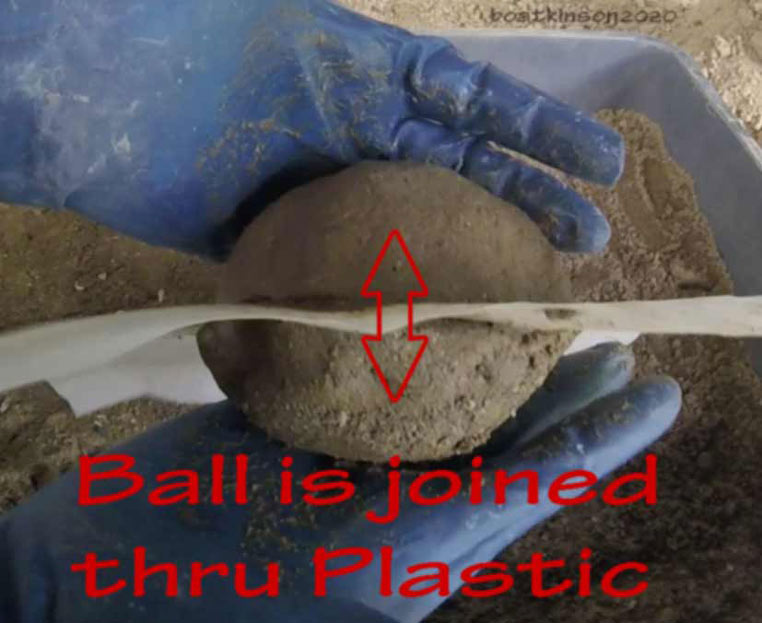
Cement balls deserve damp curing for at least a week, (or less if sun heated, by use of soil covering and/or wetted cloths sandwiched with plastic, all to assure high strength when used for anchors. Other material may be needed to secure project success in case of a windy location.
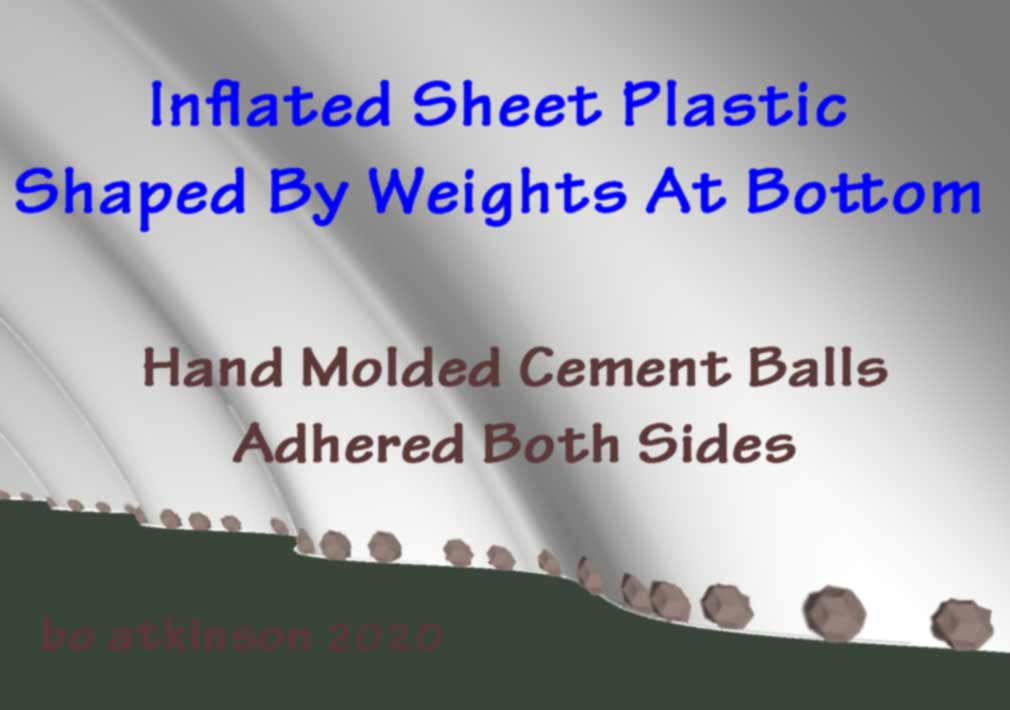
Anchors attached to plastic before inflation is one idea, but others will come, especially in case the sheet is attached to a prebuilt footing, where some other approach is due for consideration, especially because the edge to fit is likely vertical instead of flat like the ground.

Another idea for heavy weight anchors is to precast furl- shaped web like concrete pieces, to place between furls, and tidy up wrinkles of plastic. Further model details wait for another day, in case the impulse arrives

Last is a straight surface model, perhaps as an encouragement to test a smaller physical model before building a full size inflatable. Compensating for the thickness of plastic in a small vs a large model, may gain confidence that the outcome will billow out as much as as is wanted, before investing to build a large project.
~~~
My friend Steve Kornher in Mexico has used some inflated form work, and he displays examples on his website. http://www.flyingconcrete.com/daves-catenary-vault.htmll Spraying on to walls of smooth plastic has not worked well and so other remedies were used, he said. Follow the links at the bottom of his webpage to see his beautiful work and also some building information, as he primarily has used different methods for building with cement and concrete .
~~~~
After writing this page I wondered if using a coat of fast drying, wood primer paint modified with sand could provide a sprayable surface, (on PE sheets), to hold a fine cement mix with fibres, first. followed by coat(s) of thicker mixes, especially with metho-cellulose added both for adhesion and also for curing- protection to slow the drying of air- exposed cement. (Water must remain with cement until it has cured, to gain it's strength). Before spraying inflatables, tests are due first! Possibly trying some tulle netting, (left over from my contracting days of decorating large tents, for my wife's floral business); or taking a different approach by use of other fabrics, also saved from past jobs.
![]()
Note: These pages are placed in the The content on this website, http://harmoniouspalette.com, is placed in the public domain only as a free exchange of ideas and as a "hard studied wish to serve life". The author assumes no responsibility for the improper use of the concepts in these web pages. All relevant laws of life and local codes should be verified and observed before any building or experimentation proceeds. discussion is welcome, please write. Bo Atkinson and are furnished "as is". The author assumes no responsibility for the use or misuse of the concepts in this series. All pertaining laws should be satisfied, in duplicating or testing my concepts or descriptions, as these are posted on my linked pages.